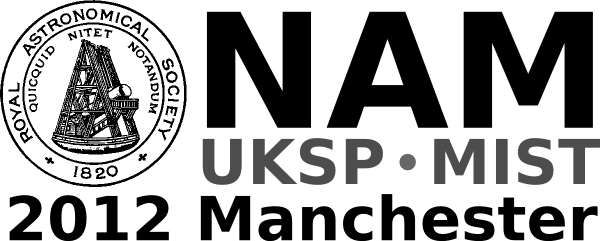UK-Germany National Astronomy Meeting NAM2012
Plenary Lectures and Community Sessions
The Square Kilometre Array
Michael Kramer
(Max Planck Institute for Radio Astronomy)
Tue 27th March 09:00-09:50
Chair: Andreas Burkert
The Square Kilometre Array (SKA) programme has the ambitious goal to construct and operate the world largest radio telescope. With a collecting area comparable to one square kilometre and many novel techniques, it will revolutionise the way we do radio astronomy. The impact of this versatile observatory goes far beyond the classical radio astronomy community, as the SKA will address the unsolved mysteries of our modern understanding of the origin and evolution of the cosmos and the physical laws that govern it. The SKA will determine the epoch of re-ionization, study the first stars and black holes, detect complex molecules in space, and may even pick up extraterrestrial TV (should it exist!) from the closest stars and their planets. The telescope will also address the question as to whether Einstein's theory of general elativity is our last word in understanding gravity by probing the properties of dark energy, the physics of black holes or by directly detecting gravitational waves and studying the properties of gravitons. The SKA programme has recently entered a new phase, which saw the installation of a legal organisation of international members in order to prepare the construction of this telescope. This talk will review the science and status of this fascinating telescope.
NASA's Juno Mission to Jupiter: What's Inside the Giant Planet?
Fran Bagenal (University of Colorado)
Tue 27th March 16:00-16:50
Chair: David Southwood
Frontiers in gravitational lensing
Peter Schneider (University of Bonn)
Wed 28th March 09:00-09:50
Chair: Simon White
Gravitational lensing has established itself as a very powerful tool in astrophysics, with applications ranging from the detection of extra-Solar planets, the study of the (dark) matter distribution in galaxies and galaxy clusters, the use as a natural magnifying tool which comes for free, to constraining the equation-of-state of dark energy and testing the law of gravity on cosmic scales. In this talk, a selection of recent research highlight will be presented, and prospects for future developments will be given.
RAS Community Session Wed 28th March 14:15-15:30
- 1415: Presidential Address by Roger Davies
- 1425: Presentation of medals to
- John Brown (Gold)
- Mike Irwin (Herschel)
- Andrew Fazakerley (Chapman)
- Joss Bland-Hawthorn (Jackson -Gwilt)
- Steve Warren and Andy Lawrence( UKIDSS- Group)
- Paul Murdin (Service)
- Becky Parker (Patrick Moore)
- Hiranya Peiris and Matt Owens (Fowler)
- Tom Kitching and Juliet Biggs (Winton)
- Hiromoto Shibahashi and Hermann Opgenoorth (Hon Fellows)
- 1515 : 'Preserving the Past for the Future' by Mike Edmunds, Chair of the Astronomical Heritage Committee
The protocloud and the large-scale environment of galaxies
Joss Bland-Hawthorn (University of Sydney)
Wed 28th March 16:00-16:50
Chair: Matthias Steinmetz
In the context of the cold dark matter paradigm, variations in galaxy properties are expected and observed across the hierarchy. In particular, galaxies in clusters are dominated by old stellar populations, in contrast to field galaxies which are gas-rich and have younger stellar populations in the main. The vast majority of field galaxies reside in groups confined to sheets and filaments, and far away from dense clusters. What is the impact of the large-scale gravitational field on the development of the field population? Is the only clear demarcation is between clusters and the field? The answer will come from the next generation of high resolution simulations and from integral field spectroscopic surveys of 100,000 galaxies.
The Wonders of the solar atmosphere
Alan Hood (University of St Andrews)
Thu 29th March 09:00-09:50
Chair: Philippa Browning
The Sun, our star, is being probed in ever increasing detail by a flotilla of spacecraft and a raft of ground-based telescopes. As we improve all aspects of resolution, the Sun continues to amaze us. Why do we need to understand how our Sun works? Obviously the Sun's activity is important for the Earth. Can we determine when CMEs caused by flares and non-flare eruptions will occur and whether they will hit the Earth or not?
All of the activity in the solar corona is due to the Sun's magnetic field and the flow of energy stored within it. The field is generated in the interior by the solar dynamo. Then, rises through the convection zone and the photosphere, creating sunspots and active regions in the process. The rising field interacts with the corona, creating waves, storing energy and heating the coronal plasma. Finally, it erupts into interplanetary space as a CME.
This talk will present some of the exciting recent observations and discuss some the theoretical ideas developed to explain them.STFC Community Session
Wed 28th March 14:00-15:30
Chair: Mike Cruise
Including a presentation by STFC CEO John Womersley.
UKSA / ESA
Wed 28th March 16:00-17:00
Chair: David Southwood
ESO
Wed 28th March 16:00-17:00
Chair: Gary Fuller
This session will provide an opportunity to discuss ESO current and future facilities and ESO's interaction with the UK and German user community. It will include presentations from Markus Patig, Magda Arnaboldi, Nicholas Cross and Pat Roche. For more information, see the ESO community session webpage.
'Photographing the Night Sky' An Introduction to Modern Imaging Techniques
Nik Szymanek
Thu 29th March 17:10-18:00
Chair: Albert Zijlstra
There has been an incredible advance in the methodology used by the modern amateur astronomer to capture images of the night sky. New detector technology, combined with advances in optics and tracking hardware, allow the 'back garden' imager unprecedented tools to produce imagery that was once only within the realm of the professional astronomer. Scientific imaging is routinely carried out by many amateurs worldwide but this talk will showcase the more aesthetic side of colour CCD imaging with a selection of images taken from both light polluted suburban sites as well as world-class Observatory locations abroad. The main part of the talk will concentrate on the production of colour images using both 'broadband' filters, for galaxy imaging, and 'narrowband' filters for imaging diffuse nebulae. Also included will be images taken from Observatory locations in the Canary Islands and, although no longer used by imagers, a selection of wide-angle images taken on photographic film.
Catching Shadows: Kepler's Year-Three Exoplanet Census
Natalie Batalha (San Jose State University)
Fri 30th March 09:00-09:50
Chair: Andrew Cameron
Humankind's speculation about the existence of other worlds like our own turned into a veritable quest with the launch of NASA's Kepler spacecraft in March 2009. The mission is designed to survey a slice of the Milky Way Galaxy to identify planets via transit photometry. The last year of science operations has been a year of milestones in terms of exoplanet characterization: rocky, Earth-size, circumbinary, Habitable Zone, and even invisible planets have made headlines. However, the mission's primary objective is to construct a catalog of transiting exoplanet candidates that can be used to study large sample statistics of exoplanet populations. The mission recently released its third catalog, containing 2,321 candidates associated with 1,790 stars. The statistics of this catalog will be described, including the properties of the multiple-planet systems that have been identified. Having completed its third year of operation, Kepler is edging closer to answering the question that drives the mission: are Earth-size planets abundant in our galaxy.
Cosmology in our backyard
Carlos Frenk (University of Durham)
Fri 30th March 16:00-16:50
Chair: Shude Mao
The LCDM cosmological model accounts surprisingly well for an impressive array of data on the large-scale structure of the universe, from scales of a few megaparsecs to a few gigaparsecs. On submegaparsec scales, however, the model cannot be tested with the same degree of rigour as on larger scales where microwave background radiation data and measures of galaxy clustering provide clean and well-understood diagnostics. Yet, it is precisely on these small scales that the nature of the dark matter manifests itself most clearly. Satellite galaxies, like those that orbit the Milky Way, are a particularly informative population. The LCDM model makes quite definitive predictions for the properties of this population and recent kinematical data indicate that the internal structure of the satellites may not be what the simplest version of the theory predicts. I will discuss possible solutions to this discrepancy, ranging from exotic baryonic processes that could alter the structure of subhalos to the more radical assumption that the dark matter is not what the standard theory assumes.





